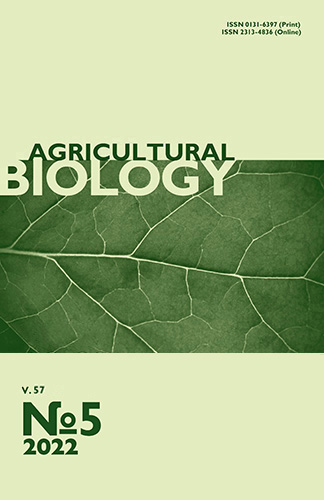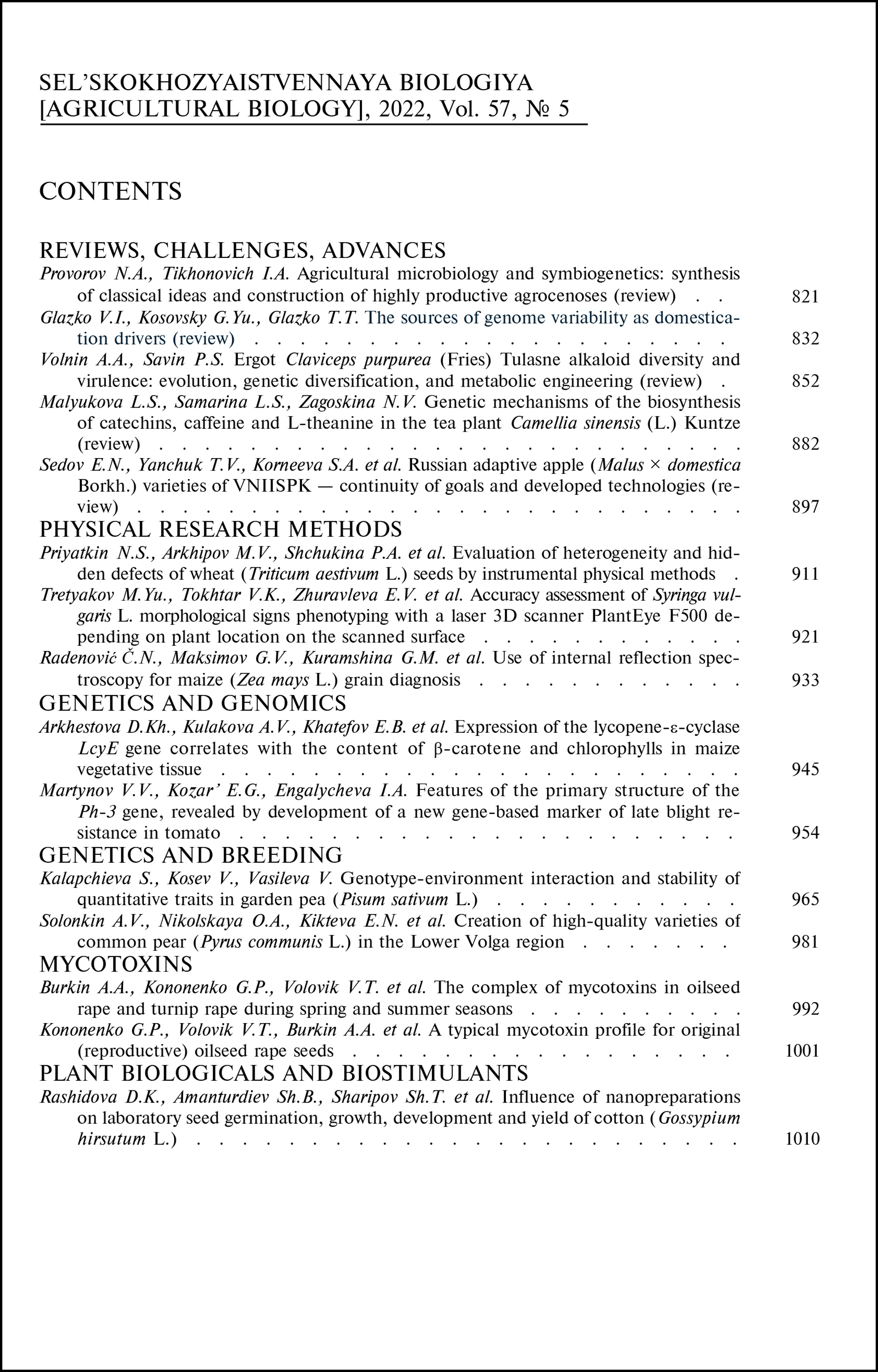doi: 10.15389/agrobiology.2022.5.965eng
UDC:635.656:631.52:575.167
Acknowledgements:
Supported financially from the National Science Foundation of Bulgaria (grant KP-06-N26/12)
GENOTYPE-ENVIRONMENT INTERACTION AND STABILITY
OF QUANTITATIVE TRAITS IN GARDEN PEA (Pisum sativum L.)
Kalapchieva1, V. Kosev2, V. Vasileva3 ✉
1Department of Breeding, Variety Maintenance and Introduction, Maritsa Vegetable Crops Research Institute, 32 Brezovsko shosse Str., 4003 Plovdiv, Bulgaria;
2Institute of Forage Crops, Department of Technology and Ecology of Forage Crops, 89 General Vladimir Vazov Str., 5800 Pleven, Bulgaria;
3Institute of Forage Crops, Department of Breeding and Seed Production of Forage Crops, e-mail viliana.vasileva@gmail.com (✉ corresponding author)
ORCID:
Kalapchieva S. orcid.org/0000-0001-6779-4712
Vasileva V. orcid.org/0000-0001-5602-7892
Kosev V. orcid.org/0000-0002-6619-9409
Received May 4, 2022
Peas are among the most common and widely cultivated annual legumes. Productivity potential of most modern pea varieties is high but limited by their low homeostasis and sensitivity to abiotic stress, i.e., the varieties tend to reduce adaptability. Therefore, one of the main challenge in pea breeding is to create an optimal genotype capable of realizing the biological potential and adequately responding to changes in growing conditions. Therefore, environmental testing remains relevant. This paper is the first assessment of the breeding samples of the pea working collection (Maritsa Vegetable Crop Research Institute, Plovdiv, Bulgaria) with respect to their ability to form economically significant quantitative traits. Three sources of variability (genotype, environment, and genotype-environment interaction) were found to be statistically significant for the total number of pods, the number of productive nodes with two pods per plant, pod weight, and grain weight. In 2018-2020, the phenotypic stability of ten pea (Pisum sativum L.) genotypes was assessed, including four perspective lines (22/16-af, 22/16-n, B4/34-n, and 1/17-n) and six varieties (Kazino-af, Plovdiv-n, Marsy-n, Echo-af, Shugar dwarf-n, and Vecherniza-n). The main examined quantitative traits were the number of pods per plant, the number of fertile nodes with one pod per plant, the number of fertile nodes with two pods per plant, pod length, pod width, pod weight per plant, and grain weight per plant. The effect of all factors of variation on the number of pods per plant, number of fertile nodes with two pods per plant, weight of pods per plant, and grain weight per plant is statistically significant. The strongest was the effect of the environmental factor on the manifestation of the number of pods per plant (52.20 %) and the number of fertile nodes with two pods per plant (59.00 %). The genotype factor has the largest contribution to the total variability of the weight of pods per plant (64.10 %) and grain weight per plant (67.40 %). Therefore, an effective breeding should be focusing on these traits regardless of the environmental conditions. The number of pods per plant and pod length requires more trials to give a more accurate estimate due to the superiority of the genotype½environment interaction variance over the genotype variance. Our findings indicate that the varieties Marsy-n and Echo-af are the most valuable genotypes for the number of pods per plant. The varieties Kazino-af, Plovdiv-n and the line 1/17-ob are highly variable and form fewer pods. For pod weight, all genotypes showed good responsiveness, especially Plovdiv-n (bi = 2.68), 1/17-ob (bi = 2.63), and Marsy-n (bi = 2.18), all three having a higher pod weight, and the Echo-af variety shows better stability (bi = 1.39; Si2 = 1.91). For the grain weight per plant, the Marsy-n (bi = 3.08), 1/17-ob (bi = 2.62), and Plovdiv-n (bi = 4.02) are highly productive but also the most variable.
Keywords: phenotypic stability, genotype, environment, yield stability, ecological plasticity.
REFERENCES
- Smýkal P., Aubert G., Burstin J., Coyne C.J., Ellis N.T., Flavell A.J., Ford R., Hýbl M., Macas I., Neumann P., McPhee K.E., Redden R.J., Rubiales D., Weller J.L., Warkentin T.D. Pea (Pisum sativum L.) in the genomic era. Agronomy, 2012, 2(2): 74-115 CrossRef
- Vasilenko A.A., Solonechnyy P.N., Ponurenko S.G. Vestnik Belorusskoy gosudarstvennoy sel’skokhozyaystvennoy akademii, 2019, 2: 191-195 (in Russ.).
- Parihar A.K., Hazra K.K. Lamichaney A., Dixit G.P., Singh D., Singh A.K., Singh N.P. Characterizing plant trait(s) for improved heat tolerance in field pea (Pisum sativum L.) under subtropical climate. Int. J. Biometeorol., 2022, 66(6): 1267-1281 CrossRef
- Amelin A.V. Zernobobovye i krupyanye kul’tury, 2012, 1: 46-52 (in Russ.).
- Belyavskaya L.G., Belyavskiy Yu.V., Diyanova A.A. Zernobobovye i krupyanye kul’tury, 2018, 4(28): 42-48 (in Russ.).
- Ponomareva S.V. Agrarnaya nauka Evro-Severo-Vostoka, 2018, 63(2): 23-28 CrossRef (in Russ.).
- Zelenov A.N., Shelepina N.V., Mamaeva M.V. Zernobobovye i krupyanye kul’tury, 2013, 1(5): 21-25 (in Russ.).
- Zhuchenko A.A. Mobilizatsiya mirovykh resursov tsvetkovykh rasteniy na osnove sozdaniya sistematizirovannykh geneticheskikh kollektsiy [Mobilization of world resources of flowering plants based on systematic genetic collections]. Moscow, 2012 (in Russ.).
- Dragavtsev V.A. Ecological and genetic screening of the gene pool and methods of designing varieties of agricultural plants in terms of yield, stability and quality. Methodical recommendations (new approaches). St. Petersburg, 1997.
- Eberhart S.A., Russel W.A. Stability parameters for comparing varieties. Crop Science, 1966, 6(1): 36-40 CrossRef
- Sabaghnia N., Karimizadeh R., Mohammadi M. Graphic analysis of yield stability in new improved lentil (Lensculinaris Medik.) genotypes using nonparametric statistics. Acta Agriculturae Slovenica, 2015, 103(1): 113-127.
- Finley K.W., Wilkinson G.N. The analysis of adaptation in a plant-breeding programme. Australian Journal of Agricultural Research, 1963, 14(6): 742-754 CrossRef
- Tai G.C.C. Analysis of genotype—environment interactions of potato yield. Crop Science, 1979, 19(4): 434-438 CrossRef
- Hanson W.D. Genotypic stability. Theor. Appl. Genet., 1970, 40(5): 226-231 CrossRef
- Plaisted R.I., Peterson L.C. A technique for evaluating the ability of selection to yield consistently in different locations or seasons. American Potato Journal, 1959, 36: 381-385 CrossRef
- Wricke G. Über eine Methode zur Erfassung der ökologischen Streubreite in Feldversuchen. Z. Pflanzenzuecht, 1962, 47: 92-96.
- Annicchiarico P. Cultivar adaptation and recommendation from alfalfa trials in Northern Italy. Journal of Genetics and Plant Breeding, 1992, 46(3): 269-278.
- Lin C.S., Binns M.R. A superiority measure of cultivar performance for cultivar ½ location data. Canadian Journal of Plant Science, 1988, 68(1): 193-198 CrossRef
- Nascimento M., Cruz C.D., Campana A.C.M., Tomaz R.S., Salgado C.C., Ferreira R. Alteration of the centroid method to evaluate genotypic adaptability. Pesquisa Agropecuária Brasileira, 2009, 44: 263-269 CrossRef
- Huehn M. Nonparametric measures of phenotypic stability: Part 1: Theory. Euphytica, 1990, 47: 189-194 CrossRef
- Huehn M. Nonparametric measures of phenotypic stability: Part 2. Application. Euphytica, 1990, 47: 195-201 CrossRef
- Yan W. Singular-value partitioning in biplot analysis of multienvironment trial data. Agronomy Journal, 2002, 94(5): 990-996 CrossRef
- Cruz C.D. Programa Genes: Biometria. version 7.0. University of Federal Viçosa, Viçosa, Brazil, 2009.
- Tolessa T.T., Keneni G., Sefera T., Jarso M., Bekele Y. Genotype ½ environment interaction and performance stability for grain yield in field pea (Pisum sativum L.) genotypes. International Journal of Plant Breeding, 2013, 7(2): 116-123.
- Bocianowski J., Księżak J., Nowosad K. Genotype by environment interaction for seeds yield in pea (Pisum sativum L.) using additive main effects and multiplicative interaction model. Euphytica, 2019, 215: 191 CrossRef
- Singh J., Kumar A., Fiyaz R.A., Singh M.K. Stability analysis of pigeon pea genotypes by deployment of AMMI model under rainfed environment. Legume Research, 2018, 41(2): 182-188 CrossRef
- Mukherjee A.K., Mohapatra N.K., Bose L.K., Jambhulkar N.N., Nayak P. Additive main effects and multiplicative interaction (AMMI) analysis of G½E interactions in rice blast pathosystem to identify stable resistant genotypes. Global Journal of Crop, Soil Science and Plant Breeding, 2013, 1(1): 103-118.
- Rana C., Sharma A., Sharma K.C., Mittal P., Sinha B.N., Sharma V.K., Chandel A., Thakur H., Kaila V., Sharma P., Rana V. Stability analysis of garden pea (Pisum sativum L.) genotypes under North Western Himalayas using joint regression analysis and GGE biplots. Genetic Resources and Crop Evolution, 2021, 68: 999-1010 CrossRef
- Nizam I., Cubuk M.G., Moralar E. Genotype-environment interaction and stability analysis of some Hungarian vetch (Vicia pannonica Crantz.) genotypes. African Journal of Agricultural Research, 2011,6(28): 6119-6125 CrossRef
- Al-Aysh F., Kotmaa H., Al-Shareef A., Al-Serhan M. Genotype-environment interaction and stability analysis in garden pea (Pisum sativum L.) landraces. Agriculture & Forestry, 2013, 59(3): 183-191.
- Goa Y., Mohammed H. Genotype ½ environment interaction and yield stability in field pea (Pisum sativum L.) tested over different locations in Southern Ethiopia. Journal of Biology, Agriculture and Healthcare, 2013, 3(19): 91-100.
- Acikgoz E., Ustun A., Gul I., Anlarsal E.,Tekeli A.S., Nizam I., Avcioglu R., Geren H., Cakmakci S., Aydinoglu B.,Yucel C., Avci M., Acar Z., Ayan I., Uzun A., Bilgili U., Sincik M., Yavuz M. Genotype × environment interaction and stability analysis for dry matter and seed yield in field pea (Pisum sativum L.). Spanish Journal of Agricultural Research, 2009, 7(1): 96-106 CrossRef
- Simion T., Mohammed W., Amsalu B. Genotype by environment interaction and stability analysis of cowpea (Vigna unguiculata L. Walp) genotypes for yield in Ethiopia. Journal of Plant Breeding and Crop Science, 2018, 10(9): 249-257 CrossRef
- Rezene Y., Bekele A., Goa Y. GGE and AMMI biplot analysis for field pea yield stability in SNNPR state, Ethiopia. International Journal of Sustainable Agricultural Research, 2014, 1(1): 28-38.
- Bhartiya A., Aditya J., Kumari V., Kishore N., Purwar J., Agrawal A. GGE biplot & AMMI analysis of yield stability in multi-environment trial of soybean [Glycine max (L.) Merrill] genotypes under rainfed condition of North Western Himalayan hills. Journal of Animal and Plant Sciences, 2017, 27(1): 227-238.
- Horn L., Shimelis H., Sarsu F., Mwadzingeni L., Laing M.D. Genotype-by-environment interaction for grain yield among novel cowpea (Vigna unguiculata L.) selections derived by gamma irradiation. The Crop Journal, 2018, 6(3): 306-313 CrossRef
- Farshadfar E., Rashidi M., Jowkar M.M., Zali H. GGE biplot analysis of genotype ½ environment interaction in chickpea genotypes. European Journal of Experimental Biology, 2013, 3(1): 417-423.
- Vaezi B., Pour-Aboughadareh A., Mohammadi R., Armion M., Mehraban A., Hossein-Pour T. GGE biplot and AMMI analysis of barley yield performance in Iran. Cereal Research Communications, 2017, 45(3): 500-511 CrossRef
- Sozena O., Karadavut U. Determination of genotype ½ environment interactions of some chickpea (Cicer arietinum L.) genotypes by using different stability methods. Journal of Agricultural Sciences, 2018, 24: 431-438.












